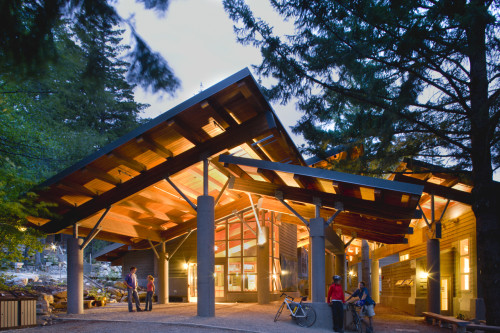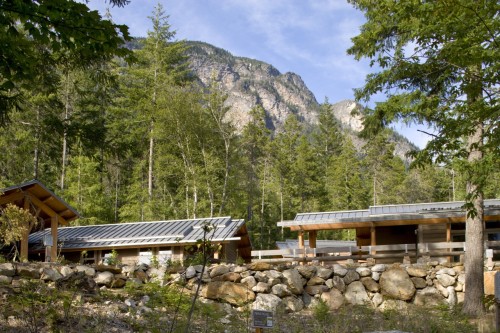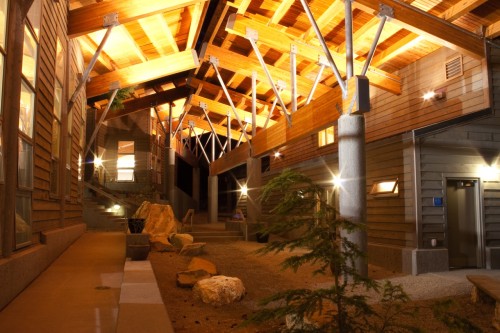North Cascades Environmental Learning Center "provides the perfect blueprint for Seattle"

In celebration of the Learning Center’s 10th Anniversary, we’re sharing one of our favorite media stories on our wilderness campus on Diablo Lake in North Cascades National Park. This was written by architectural critic Lawrence Cheek for the Seattle P-I, originally published May 29, 2006.
What might Seattle and its mindlessly ballooning ‘burbs learn from the design of a new environmental school campus cradled deep in the North Cascades? Almost everything, actually, but to start with:
Respect. Humility. Surprise. Delight. Texture. A powerful sense of place. And an even stronger ethic of responsibility to the land and to the attitudes of future generations that just may get their thinking twirled around by a weekend out there.
The North Cascades Environmental Learning Center, opened last June, occupies a dramatic site at the edge of Diablo Lake, just off state Route 20 in the heart of North Cascades National Park. Seattle City Light paid most of the $10.2 million construction cost as “mitigation” for its 1995 federal hydroelectric license. The North Cascades Institute, a non-profit environmental education outfit, is using the campus to teach everything from wildflower photography to grizzly conservation.
But the most vivid lesson is in how to slip strong, assertive architecture gracefully into the forest.

The 16 buildings are basically simple boxes and shed forms whose only overtly dramatic gestures are rooflines that thrust into space and joust with each other, like tree canopies jostling for scraps of sky. There’s no prissy decoration and no mock rusticity. “We didn’t want to create something that looked like it was depleting the very forest we’re trying to save,” says David Hall, a partner in HKP Architects of Mount Vernon, the small firm that designed the complex. Neither does it pose as spartan. The buildings announce that civilization has established a firm foothold in the forest, but we’ve come in peace.



Hall’s ethical framework for the campus fell into place before he drew anything — in fact, maybe before he became an architect. He grew up in Everett and began hiking the North Cascades in his teens. He nurtured a love for backpacking and fly fishing, and still thinks the best places are the ones without roads, or even trails. When his firm began talking with the three clients collaborating on the campus — Seattle City Light, the Park Service and the North Cascades Institute — all agreed that the site should be disturbed as little as possible and the buildings should be showcases for energy conservation and sustainability.
The first surprise is that the campus is virtually auto- and pavement-free. Cars and buses may drop off visitors and packages, but rides are then banished to a faraway parking lot. There are no sidewalks, just gravel paths, but the entire site is wheelchair-accessible despite a 125-foot rise in its slope.
Landscaping is all in the North Cascades family. Park Service people collected seeds and cuttings on site before construction started and propagated 20,000 plants for later use. Big trees were spared and the buildings slipped practically underneath them, so the year-old campus is enveloped in shade. There’s no air conditioning needed, even though the site’s elevation is only 1,200 feet. Staff members have learned to close the doors to keep ravens from raiding their snacks.

The next impression asks for a conceptual leap, but it packs a powerful emotional impact. Stroll thoughtfully through the outdoor corridor framed by the main office, classroom buildings and library, and the architecture becomes a metaphorical forest. The grainy, concrete aggregate columns suggest trunks, galvanized-steel struts peel away like branches, and the cantilevered roofs form a canopy, with slivers of sky — and rain — glancing through the openings.

To reflect the randomness of nature, Hall avoided parallels and ordered different-hued stains for the cedar siding on different buildings. The vocabulary of forms is small and tightly controlled, but the geometry of the pieces constantly shifts, offering a small but delightful surprise at every turn — just as in nature.
The interiors seem like mountain-high spaces, as even the shed-roofed classroom ceilings soar to 20 feet. The materials are painstakingly sustainable. An expiring gym donated its maple flooring. Wainscoting is formaldehyde-free, agricultural-waste wheatboard, whose amber waves of grain look deceptively luxurious. The mountain-cradled site is so dramatic that big windows were essential, and in one classroom the rising border of a trapezoid-shaped window elegantly parallels the mountain ridgeline viewed through it. Sighs Hall, “I wish I could say that was intentional.”
Maybe it’s the mountain expressing gratitude for this uncharacteristically humble gesture from humans.

It doesn’t take an architect’s eye to guess that the budget was generous, and that what HKP was able to do with this campus couldn’t literally be repeated in every school, retail development and condo cluster in greater Seattle. But the ethics from which it sprang could be used to form a baseline for everything we build, and we’d be a better city for it — more responsible, more graceful, more humane and certainly more sustainable.
Natural forms and textures would inspire architecture, buildings would be humbler and more deferential to their sites, and trees would take precedence over pavement. Architecture wouldn’t be used so much as a means to seal nature out as to integrate human life with the environment.
So here’s a radical proposal: architects should take an oath that opens with the words of Hippocrates, slightly misquoted but altogether apt in the popular version: “First, do no harm.” That was the foundation for this campus, and just look at the beauty that arose out of it.

Former North Cascades National Park Superintendent Chip Jenkins, lead architect David Hall, former Seattle City Light Superintendent Jorge Carrasco and North Cascades Institute Executive Director Saul Weisberg at the Institute’s 25th Anniversary Picnic in 20098 with the Learning Center’s LEadership in Energy and Environmental Design (LEED) Silver Rating award and Designing and Building with Forest Stewardship Council Award.
Learning Center photos by Lara Swimmer and HKP; aerial photo by Benj Drummond; group photo by Christian Martin.

